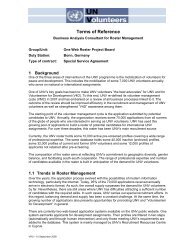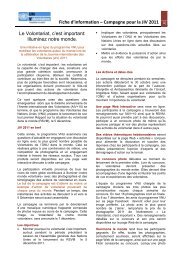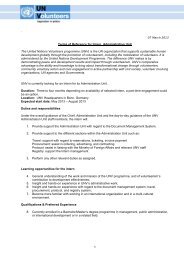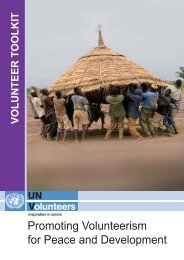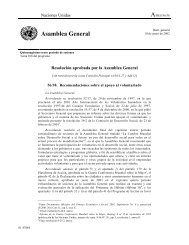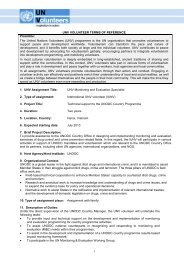View associated PDF document - United Nations Volunteers
View associated PDF document - United Nations Volunteers
View associated PDF document - United Nations Volunteers
Create successful ePaper yourself
Turn your PDF publications into a flip-book with our unique Google optimized e-Paper software.
UN <strong>Volunteers</strong> Policy Paper<br />
‘Caring Cities’<br />
Volunteering in Urban Development and the role of the <strong>United</strong> <strong>Nations</strong> Volunteer Programme<br />
PART I –<br />
URBAN DEVELOPMENT AND VOLUNTEERISM<br />
The Importance of Volunteerism in Urban Development<br />
PART I –<br />
URBAN DEVELOPMENT AND VOLUNTEERISM<br />
The Importance of Volunteerism in Urban Development<br />
Page 22<br />
usual risk factors, researchers on the subject began to draw<br />
explanations related to social cohesion. For instance:<br />
‘From the beginning the sense of common purpose and the<br />
camaraderie among the Italians precluded ostentation or<br />
embarrassment to the less affluent, and the concern for<br />
neighbors ensured that no one was ever abandoned. This<br />
pattern of remarkable social cohesion, in which the family, as<br />
the hub and bulwark of life, provided a kind of security and<br />
insurance against any catastrophe… Throughout the years of<br />
study of this community the indicators were that the strength<br />
of unconditional interpersonal support and family and community<br />
cohesiveness had served to counteract the effects of life<br />
stress… The data obtained over a span of twenty years in the<br />
Italian-American community of Roseto, when compared with<br />
those of neighbouring communities, strongly suggests that the<br />
cultural characteristics – the qualities of a social organization –<br />
affect in some way individual susceptibility to myocardial<br />
infarction and sudden death. The implication is that an<br />
emotionally supportive social environment is protective and<br />
that, by contrast, the absence of family and community support<br />
and the lack of a well-defined role in society are risk factors.’<br />
(Bruhn and Wolf, 1979: 134, after Wilkinson, 1996: 117–118)<br />
The Construction of Social Cohesion and Capital<br />
The reasoning developed above notes the pivotal importance<br />
of social cohesion for development. The construction of social<br />
cohesion in urban areas – particularly in the larger centres – is<br />
an important task. On one hand, as already noted, cities and<br />
towns are strategic for the formation of social capital as they<br />
constitute spatial entities where people congregate. On the<br />
other hand, they constitute a challenge, especially the largest<br />
cities, considering that heterogeneity is a hallmark of urban<br />
communities. Such communities lack the spontaneous stock of<br />
social capital which is generally available in places where the<br />
inhabitants share the same ethnic-cultural background. A<br />
straightforward policy implication would be the need to invest<br />
in the construction of social cohesion. Governments have a<br />
role to play in investing in social capital, in supporting the<br />
voluntary and community organizations which nurture it. As<br />
Putnam (1993) has put it: ‘For political stability, for government<br />
effectiveness, and even for economic progress social capital<br />
may be even more important than physical or human capital’.<br />
Page 23<br />
3.4. Cultural Heritage and Local Pride<br />
The preservation/reinstatement of the cultural values of a<br />
society has a significant impact on development. Deterioration<br />
of historically important material cultural assets – structures,<br />
sites, objects, books and archives – results in loss of heritage<br />
and identity, as does the disappearance of cultural expression<br />
– music, language, folklore and crafts. A given community<br />
tends to have a greater stake in a development initiative when it<br />
relates to – or at least respects – the community’s cultural<br />
foundations. Cultural heritage also plays a very important role in<br />
reinforcing the pride of a community vis-à-vis the place where it<br />
lives. There is a social identification with a given city/town as a<br />
place (geographical entity): everybody within a local population<br />
belongs to the same place. Therefore, urban conservation<br />
enhances the social identification of the population with its city.<br />
On the contrary, many initiatives are wasted precisely because<br />
they overlook cultural foundations – exemplified by cases of<br />
vandalism in public infrastructure and buildings and the lack of<br />
use of public facilities. Therefore, it is imperative to preserve<br />
and reinstate the cultural dimension of the settlements, and to<br />
reinforce the sentiment of pride that the citizens feel towards<br />
their built milieu.<br />
The preservation of culture largely depends upon voluntary<br />
actions of individuals and groups – e.g. preservation within<br />
one’s private property; care of public spaces and buildings;<br />
collective efforts to restore endangered monuments and<br />
intangible assets, etc. These are attitudes which cannot be<br />
‘bought and sold’ in the private market; they are fundamentally<br />
based in voluntary/free will.<br />
The relationship between volunteerism and cultural heritage/local<br />
pride, if supported, provides the opportunity for the establishment<br />
of a virtuous cycle. This includes the preservation of the<br />
local culture; enhancement of the local pride increases people’s<br />
motivation to further invest in their settlement (i.e. increased<br />
propensity to do volunteer work). This additional investment in<br />
their place will generate further impact on the cultural heritage,<br />
local pride and so forth.




